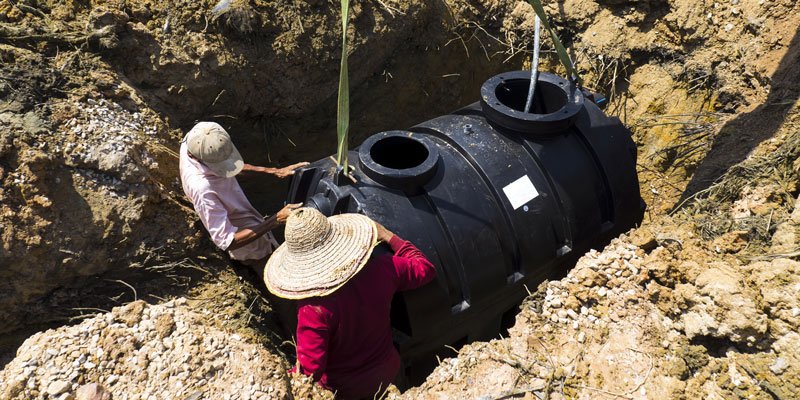Septic tanks are private, at-home, on-site sewage facilities that treat wastewater and sewage. These in-ground, watertight utilities are made from concrete, fiberglass or other materials. Septic tanks help prevent groundwater contamination. These structures can cleanse 1,000 gallons of wastewater from a home before releasing it back into the environment. Wastewater enters the tank from sewer pipes inside a home, waste breaks down within the tank, then flows out another end.

When a septic system fails, the untreated wastewater can seep into the soil and pollute groundwater. These contaminants can trigger deadly outbreaks of typhoid fever, dysentery, and hepatitis. The nitrates in this water can also harm lakes and sub-streams.
Maintaining your septic system is important for three reasons:
- First, neglecting regular maintenance can cause your septic tank to rupture. Annual maintenance costs are minimal. The average fees run $100 to $300. This is inexpensive compared to the costs of replacing a failing system. A new septic tank can cost homeowners $3,000 to $10,000, depending on its size.
- Second, maintaining your septic system protects your family’s health and the local environment. When untreated wastewater seeps into the environment, it contaminates drinking water.
- Finally, maintaining your system will also help your property keep its value. Damaged septic tanks release pollution, which not only degrades your home’s value, but it also impacts area property values.
Septic System Maintenance
How can you maintain your septic system? Protect your tank by following tips to help you keep your septic tank running smoothly.
- Have a licensed service contractor inspect your septic tank annually and have it pumped every 1-3 years.Record all inspections, repairs, and maintenance-related activities. Provide all service-related materials to your contractors. Pumping is a simple step that will keep your system optimized. Size will dictate the frequency at which you need your tank pumped. Don’t climb into your septic tank to make repairs. Toxic gases inside the tank can kill a person within minutes. Leave all repairs to a licensed professional.
- Know where your tank and drainfield are and protect them. Knowing where your tank is will save your contractor trouble of finding its location. You will save money and reduce the number of billable man-hours. You may also want to keep a schematics map of your tank.
- Divert sources of water (like roof drains, sump pump) away from your septic tank. Groundwater prevents the soil near your drainfield from purifying any wastewater.
- Minimize garbage disposal use. These kitchen utilities can increase solids entering your tank by 50%. Eliminating disposal use can decrease the grease and solids entering your drainfield. Throw away food items instead. Learn if your tank can handle garbage disposal waste from your local government.
- Don’t drive over your drainfield or septic tank area.
- Don’t plant anything but grass over your septic tank. Trees and shrubs have large roots that can rupture your septic tank.
- Don’t dig or build near your septic tank. The equipment can rupture your tank, leading to costly repairs.
- Conserve water to avoid taxing your septic tank system. Repair all leaky faucets and fix broken toilets to manage the water entering your tank. Select the proper laundry size when washing clothes. This will prevent excess water from overloading your tank.
- Always use septic-tank friendly toilet tissue. The tissue should easily break down inside your septic tank.
- Don’t throw away large, disposable items in your toilets. These include paper towels, tissues, sanitary napkins, cigarettes, condoms, and other items. Only wastewater and toilet paper should be used in your commode.
- Don’t flush toxic chemicals down your toilet. These chemicals include paint thinners, varnishes, gasoline, pharmaceutical drugs, and more. They can disrupt the anaerobic bacterium’s ability to break down solids and waste.
- Use bleach, drain cleaners, and other household cleaning products in moderation. Most household cleaners will not affect your septic tank. Harsh drain cleaners kill good bacteria within your tank and stop it from working.
- Call a professional when you experience any problems with your tank.
Brian Wear Plumbing strives to ensure that each one of our customers’ plumbing and maintenance issues is handled. We also provide plumbing inspections to make sure future plumbing problems are realized and stopped before they can cause serious damage. For more information, contact us today.
If you are in Columbia, MO or the mid-Missouri area and believe you have a plumbing problem, contact us.



